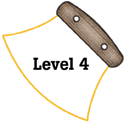
Alaska Science
Key Element A15
 |
Alaska Science |
|
Performance Standard Level 4, Ages 15–18
|
|
|
|
Sample Assessment Ideas
|
|
|
Expanded Sample Assessment Idea
|
|
Procedure Students will:
Reflection and Revision
|
Levels of Performance |
||
|
Stage 4 |
Student research incorporates multiple sources of information. Data collected is extensive, and relevant to the conditions at the assigned fishery site. Student’s work demonstrates extensive evidence of knowledge related to environmental problem solving. | ||
|
Stage 3
|
Student research incorporates several sources of information. Data collected is relevant to the conditions at the assigned fishery site. Student work demonstrates some evidence of knowledge related to environmental problem solving. Minor misconceptions may be evident. | ||
|
Stage 2
|
Student research uses limited sources of information. Data collected is relevant to the conditions at the assigned fishery, but lack detail. Students work demonstrates limited evidence of knowledge related to environmental problem solving. Student work may be incomplete, incorrect, lacking detail, or contain errors of reasoning. | ||
|
Stage 1
|
Students research may be on topic, but is limited in scope. Data shows little or no evidence relating to the assigned fishery site. Students work is largely incomplete, incorrect, and may show major misconceptions. | ||
Standards Cross-References
|
||
|
National Science Education Standards Organisms both cooperate and compete in ecosystems. The interrelationships and interdependencies of these organisms may generate ecosystems that are stable for hundreds or thousands of years. (Page 186) Living organisms have the capacity to produce populations of infinite size, but environments and resources are finite. This fundamental tension has profound effects on the interactions between organisms. (Page 186) Human beings live within the world’s ecosystems. Increasingly, humans modify ecosystems as a result of population growth, technology, and consumption. Human destruction of habitats through direct harvesting, pollution, atmospheric changes, and other factors is threatening current global stability, and if not addressed, ecosystems will be irreversibly affected. (Page 186) Human populations use resources in the environment in order to maintain and improve their existence. Natural resources have been and will continue to be used to maintain human populations. (Page 198) Humans use many natural systems as resources. Natural systems have the capacity to reuse waste, but that capacity is limited. Natural systems can change to an extent that exceeds the limits of organisms to adapt naturally or humans to adapt technologically. (Page 198) Natural ecosystems provide an array of basic processes that affect humans. Those processes include maintenance of the quality of the atmosphere, generation of soils, control of the hydrologic cycle, disposal of wastes, and recycling of nutrients. Humans are changing many of these basic processes, and the changes may be detrimental to humans. (Page 198) Materials from human societies affect both physical and chemical cycles of the Earth. (Page 198) |
Benchmarks The variation of organisms within a species increases the likelihood that at least some members of the species will survive under changed environmental conditions. A great diversity of species increases the chance that at least some living things will survive in the face of large changes in the environment. (Page 105) Ecosystems can be reasonably stable over hundreds or thousands of years. As any population of organisms grows, it is held in check by one or more environmental factors: depletion of food or nesting sites, increased loss to increased numbers of predators, or parasites. If a disaster such as flood or fire occurs, the damaged ecosystem is likely to recover in stages that eventually result in a system similar to the original one. (Page 117) Human beings are part of the Earth’s ecosystems. Human activities can, deliberately or inadvertently, alter the equilibrium in ecosystems. (Page 117) |
|
Table of Contents | Return to Alaska Native Knowledge Network